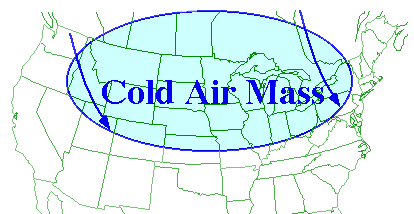In Table 13.1 a two-letter system was introduced for the classification of airmasses. One letter indicates whether the air lingered over the ocean or over land, and the other indicated the approximate latitude of the source region. For instance a cP airmass forms over a continent at a high latitude (50-60° ) (Fig 1).
One of the founders of synoptic meteorology, Tor Bergeron (1891-1977), was the first to propose a comprehensive airmass classification (1). His system was more complex, consisting of three letters. The first indicates whether that surface was marine or continental, the second shows the latitude of the source region, and the third is a measure of temperature anomaly due either by meridional movement or by local SST anomalies. For instance, air moving towards the equator is colder than normal (Fig 1).

Fig 1. Typical location of a continental polar (cP) airmass in winter in North America. A well-defined, propagating cold front is usually present on the southern and eastern edges of this airmass.